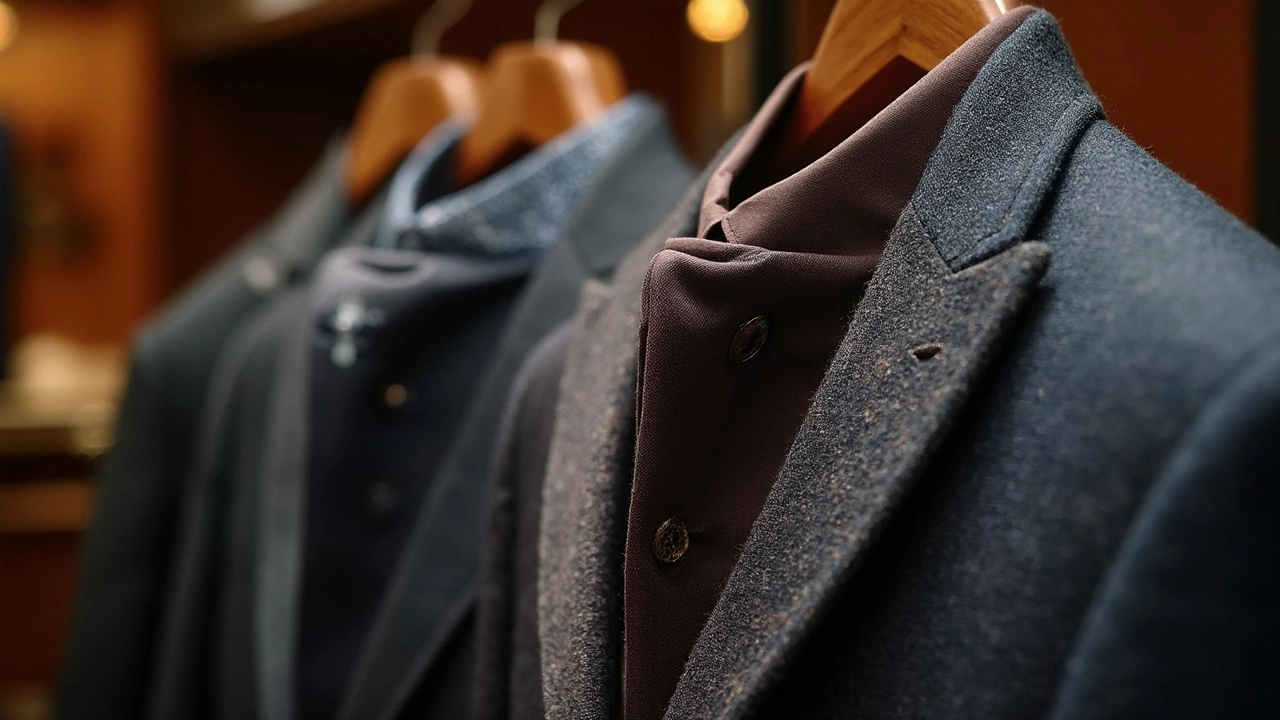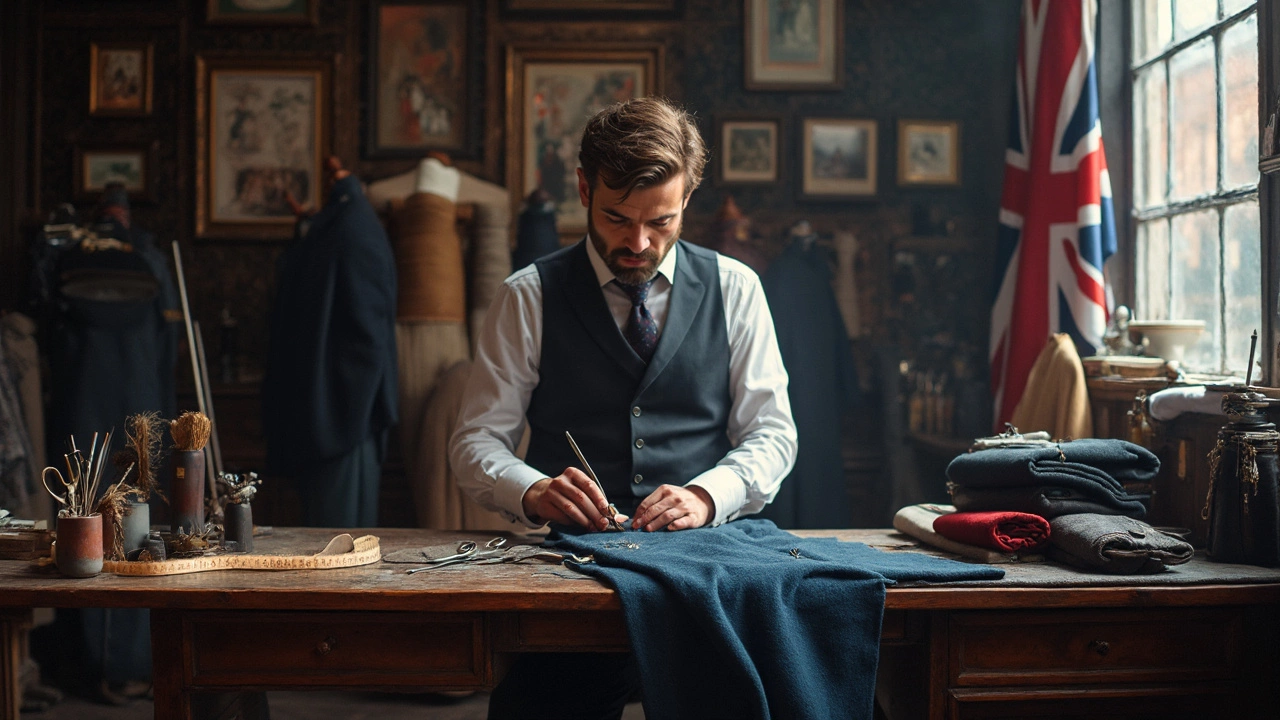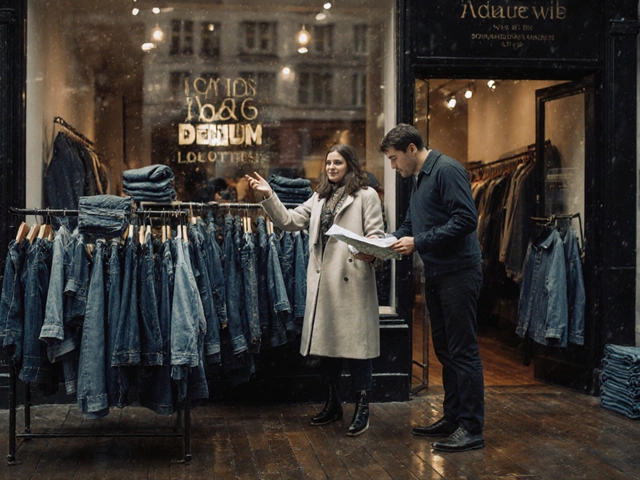Recognizing the difference between a cheap and expensive suit isn't just about price tags—it's about understanding details. Let's kick things off with fabric. Expensive suits typically use high-quality wool, like merino or cashmere, offering a luxe feel and impressive durability. Cheap suits may opt for polyester blends that just don't breathe well or last long.
Next up, take a look at the stitching. Fine suits have stitching that holds strong and is barely noticeable. Cheap options might skip on proper stitching methods, leading to corners cut—literally. Check the seams and pay close attention to any loose threads hanging about.
- Fabric Quality
- Stitching and Construction
- The Lining Check
- Buttonhole Details
- Weight and Fit
- Brand and Price Tags
Fabric Quality
When it comes to choosing between a cheap suit and an expensive suit, the fabric quality is the first game-changer. Premium suits are often crafted from pure wool or wool blends. Wool not only feels luxurious but also breathes, regulates temperature, and drapes beautifully over your body. A fine option you might encounter is merino wool, known for its softness and flexibility.
On the other hand, cheap suits tend to use synthetics like polyester. You might get stuck feeling too warm in these since they don't breathe as well. Polyester blends are popular for lower-end production because they're cost-effective and wrinkle-resistant—though they can have a shiny look that screams 'cheap'.
The Super Numbers Explained
You might have heard of 'Super 100s' or 'Super 150s'. What’s that about? Well, these numbers refer to how fine the fibers are—the higher the number, the finer and more delicate the wool. Super 100s are a great middle ground for durability and softness, while Super 150s offer a superior feel used in more lavish suits. But beware, anything above Super 180 might be too delicate for daily wear.
Look for Natural Blends
Sometimes, suits include a blend of cashmere or silk with wool. These blends offer added softness and a nice touch but will raise the price. Still, they can be worth it if you're after that luxury feel.
To sum it up, don't skip on checking the label for fabric content. If the fabrics are foreign to you, take a moment—it could help you make an informed choice. Remember, a proper quality fabric is an investment in both comfort and style.
Stitching and Construction
When it comes to identifying a cheap suit versus an expensive suit, the stitching and construction really tell you a lot. First off, let’s talk about the technique. Cheaper suits often use what's called fused construction. This is essentially a glue method where layers are stuck together. It doesn't give the same kind of structured fit you'll find with more expensive suits, which usually feature canvassed construction. Canvassed uses a layer of horsehair that molds to your body's shape over time, providing that polished look that just fits right.
Let's dive a bit deeper into stitching. Expensive suits will have dense stitching, often done by hand, especially around areas like the lapel or pockets. That hand-stitching technique gives the fabric a slight roll, which looks super elegant. Cheap suits, on the other hand, tend to have machine stitching that's often loose and can lead to issues after just a few wears.
Check out the buttonholes too. This one's a real giveaway. On pricier suits, buttonholes are hand-sewn with tight, secure threads. If you spot some uneven or frayed edges around buttonholes, that's usually a sign of a lower-quality suit.
Spot-Check Tips
- Run your fingers along the seams to feel for any bumps or uneven stitching—smooth is key.
- Hold the suit up to the light and see if any glue shows through the fabric.
Looking for these details can save you from overspending on something that doesn't hold its shape or style. Knowing these suit quality pointers not only makes you a smarter shopper but also ensures your style stays sharp.
The Lining Check
When you're trying to figure out if a suit is cheap or expensive, don't skip checking the lining. It's more than just an inside fabric; it can totally speak about how well a suit is made. First off, the lining quality adds to the suit's comfort and how it hangs on your body. Top-notch expensive suits often use natural materials for linings, like silk or high-end Bemberg, which feel great on the skin and help with breathability.
For cheap suits, you'll typically find synthetic linings like polyester. They might not sit as well and can feel a bit sticky in the heat. Plus, these synthetic linings aren't as durable, which might mean your suit showing wear and tear sooner than you'd like.
Details to Spot
Poke around the inner pockets and seams. An expensively tailored suit will have finished, clean stitching around these areas. If you're noticing loose threads or unfinished edges, it's probably not a premium suit.
Sometimes, suit linings even include small patterns or labels from reputable fabric makers, like Loro Piana or Ermenegildo Zegna. If you see these, it's a good sign of quality.
Remember, paying attention to these details can tell you stories about the suit's overall quality, so next time you're out shopping, take a peek inside!

Buttonhole Details
Looking at the buttonholes can be a real eye-opener when distinguishing a cheap suit from an expensive suit. The craftsmanship in buttonholes often reflects the overall quality of the suit.
Hand-Stitched vs. Machine-Made
High-end suits often feature hand-stitched buttonholes. These are neat, tight, and give an artisanal touch to your suit. With a handmade buttonhole, you'll notice slight imperfections, which are actually a mark of skilled craftsmanship.
On the flip side, cheaper suits might have clean and precise looking buttonholes, often done by a machine. While they may look flawless, they lack the personal touch found in hand-sewn suits. Machine-stitched holes can unravel quicker due to less robust techniques.
Quality of Buttons
Buttonhole quality also relates to the buttons themselves. Expensive suits usually come with natural materials such as horn, bone, or real mother of pearl. They're more durable and stylish.
Cheap suits, however, tend to feature plastic buttons. They can chip easily and over time lose their luster, which makes them look dull and worn out.
Bonus Tip: Functional Buttonholes
Functional buttonholes, sometimes known as "surgeon's cuffs," are often found on more expensive or custom suits. These aren't just for show; they demonstrate extra cost and time spent in tailoring. While not essential, it's a cool feature that adds flexibility and authenticity.
So next time you're examining a suit, take note of those buttonholes. They're a small element with a big impact on the overall impression and quality assessment of the suit.
Weight and Fit
When it comes to suits, weight and fit are big deals. An expensive suit often feels lighter, even though it might use more or better material. Why? It has to do with the type of fabric and how it's constructed. High-end suits are usually made from lighter, finer wool, which makes them more comfortable over long wears.
Fit is another crucial element. A good fit can make you look sharp and confident, while a bad one... well, you get the picture. Expensive suits generally offer a tailored fit. They're designed to follow the contours of your body without feeling snug or loose, giving you that sleek silhouette everyone admires.
Off-the-Rack vs. Tailored
Most cheap suits are off-the-rack, meaning they're designed to fit a range of body types but aren't cut specifically for yours. This might mean a little extra material here or there. More expensive suits often offer the option of the tailor-made route, where every measurement of your body is taken into consideration. This isn't just about looking good—it’s about comfort and how you move in your suit.
- Expensive Suit Fit: Measured to fit your body, often with extra material on sleeves and pants for adjustments.
- Cheap Suit Fit: Generic sizing may require numerous alterations to fit properly.
One way to test a suit's weight and fit? Try performing basic moves—raise your arms or sit down. In an expensive suit, these activities should feel natural, while in a cheap one, you might feel some resistance or tightness.
Brand and Price Tags
Ever ponder why two suits that look similar at first glance have drastically different price tags? A lot of this comes down to the brand and its reputation. High-end brands like Armani, Zegna, and Tom Ford have made their mark by consistently delivering quality and style you can trust.
These brands command higher prices because you've got craftmanship that requires skill and time, not to mention premium materials they're using. Sure, the label might add a bit of glamour and prestige, but there's also real value behind it. Brands invest in expert tailors, innovative designs, and superior fabrics—things that justify the higher cost.
Understanding What You're Paying For
Don't get duped by a big price tag, though! While reputable brands guarantee standards, there are others that might charge more just for name recognition without offering much in return. Here's what to check when sizing up a suit:
- Material Source: Is the wool sourced from top mills like Vitale Barberis or Loro Piana?
- Country of Origin: Suits made in Italy or the UK often have a heritage of fine tailoring.
- Tailoring Process: Look for evidence of hand-stitching or custom fittings offered by the brand.
If you're really interested in numbers, consider this: a well-made suit can last years longer than a cheaper one, offering value over time despite the initial investment.
Investing Wisely
Recognize the alignment between your budget and expectations. If you're just starting out, there are many great mid-range brands that balance price and quality. But remember, it's not about how much you spend—it's about understanding what you're getting for your money.





